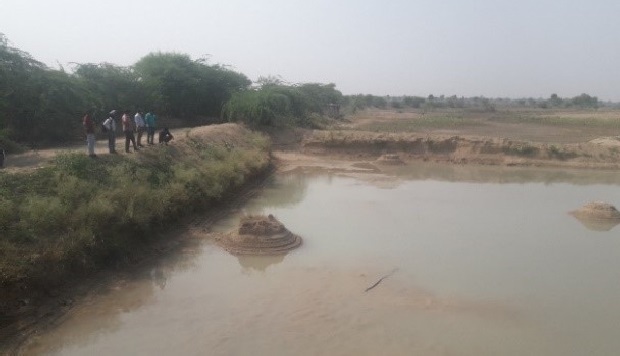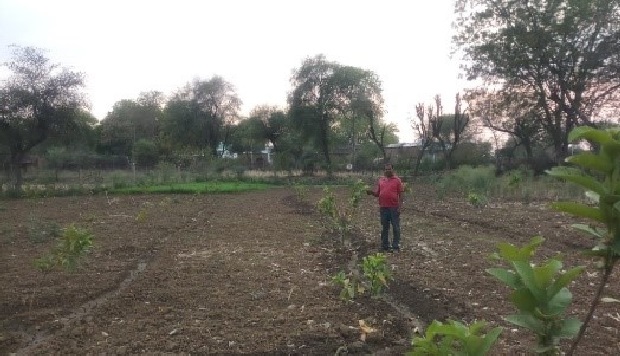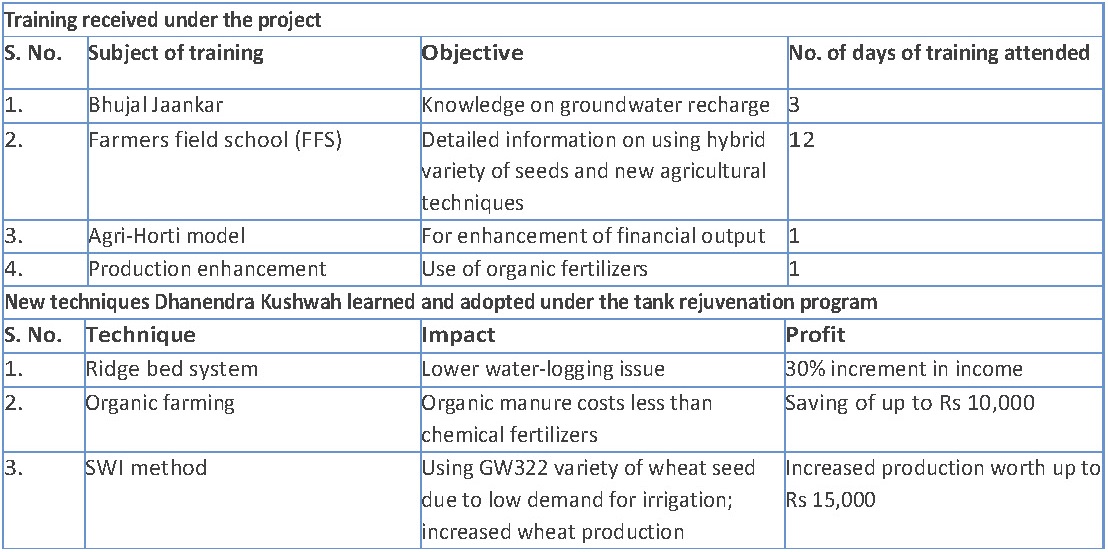|
Tank Rejuvenation Proves
Beneficial
for Farmers and Nature
Case
Study 1
Increasing water availability in Pathram village
Water management is a part of the traditional approach to improve
agricultural practices. Development Alternatives is implementing micro
project in Patharam village of Niwari block of Niwari district, Madhya
Pradesh. The project, funded by Marico, aims to restore a traditional
water body in the area and facilitate storage of rainwater.
In Patharam, an old tank was in poor condition. To increase water
availability in the tank, a check dam was constructed near the tank 15
years ago. Due to siltation in tank, the storage capacity was very low
and it was not effective. There are farmers’ fields around the tank
catchment area, which is around 1 km in length, and the entire area was
dependent on the tank for irrigation purposes.
 Tank rejuvenation work Tank rejuvenation work
After a formal meeting with the village pradhan, it was decided to
rejuvenate the tank. With the help of earth-moving machinery, other
equipment and labour, de-siltation was done and the tank was deepened. A
total of 3,210 cubic metres of silt was excavated from the tank. The
farmers who have their fields near the tank took it and constructed
bunds around the field. The rest of the excavated silt was used for the
tank bund, which increases storage of rainwater.
Benefits
Farmers were able to cultivate Rabi crops such as wheat, grams, and peas
after this operation. They irrigated these crops four times, which was
necessary for excellent output. Farmers also built bunds around their
fields to prevent soil erosion and silt deposition in the tank. The
trees around the tank, such as neem, sheesham, and mahua, are green and
healthy at this time due to the abundance of water in the tank.
The water storage capacity of the tank increased from 2,416.08 cum to
3,507 cum after the deepening. Currently, the tank has a capacity of
storing 5,923.08 cum water and more than 100 ha of land is irrigated
from this tank.
Changes observed
The open wells that would dry up by February now have water due to the
deepening of the tank. With the water availability in the tank, some
farmers have started doing aquaculture in the tank which has given them
an additional profit of up to Rs 10,000.
 Case Study 2 Case Study 2
Tanks deepening leads to double cropping
People in Radhapur village were reliant on a tank known as Bundela
Mandir Talab for their livelihoods because it was the primary supply of
water for agriculture. In the field of a farmer named Maniram, there was
a large well beside this tank. The level of water in the well was also
influenced by the amount of water in the tank. The water level in the
well was dropping year after year, and only two or three irrigations for
wheat production were possible.
Tank Rejuvenation work
The tank in Radhapur was deepened and restored as part of the Marico
tank rejuvenation project. This resulted in the tank's water storage
capacity increasing as well as the groundwater level rising. As a
result, there was more water available in Maniram's well and the soil in
the field is now moist throughout the year. He has begun to grow two
crops on the same plot of land.
Benefits
After the deepening of the tank, the water level in the well is up by 10
feet, this time Maniram is happy and is thankful to the DA team and the
Marico-supported program for this intervention in his village.
The total water storage capacity of the tank has increased from 4,787.73
cum to 13,405.44 cum. Around 20 to 30 farmers have started double
farming system.
Case Study 3
Benefits of modern tools for traditional practices
Dhanendra Kushwah of Kacchipura village is a progressive farmer with a
family of seven members including himself. As Kacchipura is in a
somewhat hilly region, the majority of its population has only two
options for livelihood: agriculture and animal husbandry. Dhanendra is a
middle-class farmer who owns a total of nine acres of land and mainly
depends on crop production for his income.
Financial challenges
Less availability of water and low rainfall in the Bundelkhand region
make high crop production difficult. Dhanendra’s annual income was
approximately Rs 90,000, and the financial condition of his family was
worsening day by day.
 A step towards a new beginning A step towards a new beginning
In April 2020, Dhanendra joined the Marico tank rejuvenation project. He
participated in training and exposure to build capacity for soil
conservation and water management methods.
After he was trained in using hybrid seeds for growing crops, Dhanendra
implemented this technique in his field. That increased the yield of his
crops of vegetables such as tomato, ladyfinger, brinjal, cauliflower,
beans, bitter gourd and pumpkin, spices such as garlic, chilli, turmeric
and coriander, and legumes such as gram.
Life-changing intervention
Working with the DA team under the Marico project, Dhanendra has learnt
a lot of new techniques and methods which have helped him increase his
income. He has also found a new vision for practising agriculture by
adopting modern farming methods.

Dhanendra says, “I have built an additional
resource for better future. I have grown 55 mango trees, 55 guava trees,
50 karonda plants, 20 teak trees, 10 sheesham trees, 5 neem trees, 5
bamboo trees and 10 munga trees which will not only enrich the
environment and give additional income to me.”■
Rishabh Singh
rsingh@devalt.org
Back to Contents
|
 Tank rejuvenation work
Tank rejuvenation work Case Study 2
Case Study 2 A step towards a new beginning
A step towards a new beginning